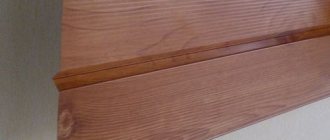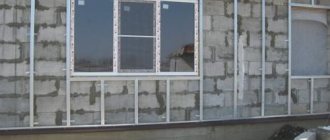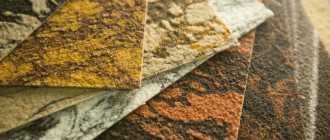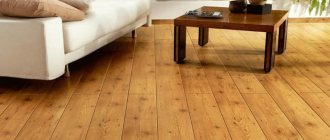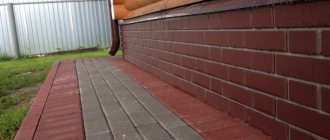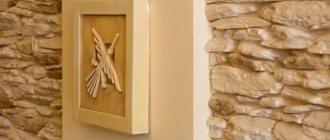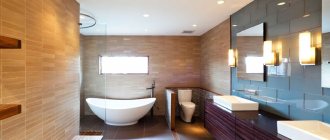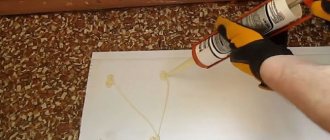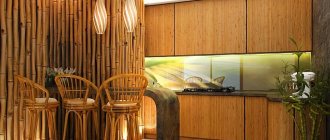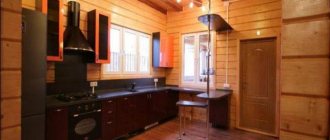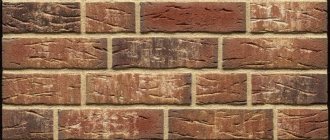Kinds
Manufacturers use the following materials to produce stone siding:
Metal
Made of galvanized steel with a polymer protective coating.
The stamped relief, repeating the texture of various types of masonry, is covered with several protective and decorative layers, resulting in a panel with a very authentically made surface.
The material is somewhat thicker than conventional metal siding, which increases the overall weight of the skin, but the strength of the fabric is much higher, and the reliability of such skin is very high. At the same time, stone-look metal siding is almost twice as expensive as vinyl samples.
Vinyl
Vinyl siding is lightweight, which reduces the load on the supporting structures of the house. This makes it possible to finish buildings with a large wall area without overloading them with additional elements.
In addition, the specificity of plastic provides ample opportunities for high-quality imitation of the texture of stone with maximum accuracy and reliability.
The shapes for plastic panels are copied from natural masonry, and the properties of the plastic make it possible to make the surface as close as possible to natural granite, sandstone or marble.
One of the weaknesses of vinyl siding is its relatively low strength and fragility in cold weather, which requires careful handling of the skin.
In addition, vinyl expands quite strongly when heated, so this feature must be taken into account during installation.
Acrylic
Acrylic stone siding has almost the same characteristics as vinyl siding, although the production technology is different. The material is more resistant to heat and is neutral to a number of chemicals. Slightly more expensive than vinyl.
Fiber cement
Fiber cement siding is a new product in the Russian market, although it has been used in the West for a long time. The material is extremely durable, resistant to atmospheric and mechanical stress.
Information about it is quite scarce, but we can definitely say that it is very heavy (1 sq. m. weighs about 15 kg, a fully paneled house will receive an additional load of several tons), the thickness of the panels is 10 mm.
In addition, such material is very expensive - the cost of fiber cement panels exceeds even the most expensive wooden samples. Such qualities significantly reduce the interest of homeowners, although manufacturers claim the unsurpassed properties of the material.
IMPORTANT! When choosing a material, you should familiarize yourself with its characteristics, since the constant search for new, more durable and reliable types of cladding brings improved types of siding to the market, often without the disadvantages of earlier models.
Types and characteristics of stone imitation panels
At the moment, there are several main varieties with different performance characteristics.
On a note! In most cases, stone-look finishing panels are classified as basement panels, because initially they were produced specifically for such work, but due to their attractiveness, they began to be actively used for cladding facade surfaces.
Basement siding can be used both for cladding the foundation and for finishing walls
Vinyl
This material is made from PVC and special additives; additional components improve quality indicators. Main characteristics of vinyl siding:
- Light weight. Even the basement material does not exert a significant load on the building.
Vinyl models are considered the lightest - Strength. The resulting coating perfectly withstands various mechanical influences.
- Temperature resistance. The surface can withstand many cycles of freezing and thawing. But at low temperatures, the likelihood of damage to the panels increases.
- Decorative. Plastic material has different textures and colors. Many manufacturers produce exclusive options with a stone effect.
- Temperature expansion. This leads to the need to leave expansion gaps.
- Low fire resistance. When exposed to flame, the surface melts and releases caustic substances.
Working with vinyl parts is quite simple. There is a wide variety of coatings obtained (see photo), which allows you to combine the finishing of the facade and base.
Vinyl trim to look like stone or brick comes in a wide variety of textures and colors.
Metal
Stone-look metal siding is made of galvanized steel, which is rolled and stamped. Due to this, it is possible to obtain a very expressive imitation.
Metal siding imitating stone cladding
Features of the material:
- Strength. Even under severe mechanical stress, the structure of the panels is not damaged, and the pronounced texture significantly reduces the visibility of damage.
- Fire safety. The material is not flammable and does not serve as a source of flame propagation.
- UV resistance. The finish retains its visual appeal for a long time and does not require special care.
- Durability. Metal siding is impervious to seasonal temperature fluctuations and neutral to moisture, which ensures a service life of over 15 years.
- Possibility of corrosion. If the integrity of the protective layer is damaged, damaged areas begin to rust. Corrosion can also occur on cuts, so it is recommended to treat them with a protective compound.
- Considerable weight. The parts are much heavier than the polymer varieties, so their installation is carried out after more thorough preparation of the base.
The budget option for stone-look metal siding is limited to a pattern on smooth panels.
Metal siding, due to its small decorative range, is less popular than PVC products, but is an excellent option for finishing a base.
Acrylic
This is a more modern type of vinyl material, in the production of which an acrylic copolymer is used, which is responsible for improved properties. Such siding products have the following characteristics:
- UV resistance. The lining does not fade.
- Strength. The surface is able to withstand significant temperature changes (from – 60 to + 60 degrees).
- Decorative. The front layer has a rich color.
- Resistance to chemical reagents.
Acrylic siding is visually similar to vinyl, but the quality of the former is much higher
. This type of finishing product is not widespread, since it appeared relatively recently and is quite expensive.
Fiber cement
This variety is made mainly in the form of siding for the base. The fact is that fiber cement parts have significant weight, so it is not practical to use them for cladding the entire house. But they combine well with other options, creating the feeling of a natural surface.
Fiber cement panels imitate natural stonework as closely as possible
The demand for products remains low due to the cost being higher than other types.
Using stone siding
Although the material itself looks quite beautiful, it is important to choose the right pattern for the aesthetic design of the external or internal walls of a building
Exterior siding
The finishing of building facades with siding must be provided for at the construction stage. If you decide to cover all the walls with this decorative material, it is better to give preference to vinyl panels, which are light in weight and will not create additional pressure on the box. For powerful concrete and brick buildings, the choice of material can be anything. When choosing a material pattern, it is worth considering that large stonework looks great on large buildings, but for a small house it is better to choose a material that imitates small stone.
In buildings with several floors, stone-look siding is used to decorate, in most cases, individual architectural elements: partially walls, a plinth, a bay window, etc. The exterior decoration looks beautiful when delineating the surfaces of the plinth and walls by using different siding textures and its shades. If there are several buildings on the site (a gazebo, a bathhouse, etc.), they can be decorated in the same style as the house, using the same texture of the material - this option will look very stylish, emphasizing the excellent taste of the owner and the beauty of the stone surrounded by greenery.
The stone goes well with other types of finishing, for example, with decorative plaster, wood, and blockhouse. In the photo you can see the magnificent tandem of stone siding that marks the central part of the building, with smoothly plastered walls and entrance columns. A striking example would be modern chalet-style houses, where the lower part of the building is decorated with basement siding, and the top is made of wood or materials imitating it.
Stone siding in the interior
In modern interior decoration, the most popular lately is siding that imitates brickwork. It can become a worthy decoration for a cozy living room; sometimes the material is used to decorate a kitchen space, but it is better to be careful not to place it near the fire. In the corridor, imitation of natural stone is used, as a rule, sporadically - corner areas, niches, and doorways are decorated with siding. You can also find this type of decoration on balconies, which will look warm and cozy even in the cold winter.
Characteristics of stone-look facade panels
To choose the best option for finishing the facade of a building with stone, you should study the characteristics of each type of siding and learn about the advantages and disadvantages.
Specifications and Dimensions
The parameters vary depending on the material used to make the panels.
| Material | Length, mm | Width, mm | Thickness, mm | Service life, years | Permissible temperature fluctuations, °C |
| Fiber cement | From 1200 | From 306 | 6-35 | 30-50 | -40 – +50 |
| Metal | From 600 | From 170 | From 5 | 10-30, depending on the quality of the polymer coating | -55 – +80 |
| Vinyl, acrylic | From 1000 | From 230 | From 1 | 40-50 | -50 – +50 |
Advantages and disadvantages
Advantages of stone-look façade siding:
- Easy to install. The modules are fixed to the wall with glue or to the lathing; the work takes little time.
- Affordable price. The cost of the material is significantly lower than finishing with natural stone.
- Light weight. The blocks do not overload the foundation; its strengthening is not required.
- Life time. Subject to the work technology and operating conditions, the coating retains its appearance and properties from 15 to 50 years.
- A variety of textures and colors. You can choose the material to the color of the roof and façade .
- Easy to care for. Dirt can be removed from the surface by wet cleaning.
- Resistance to environmental influences. Most materials do not absorb water, do not fade, tolerate low (up to 50 ° C) temperatures, and are not susceptible to mold. This ensures reliable protection of the walls of the house from destructive factors.
- Maintainability. If damaged, a separate element can be replaced with a new one without refinishing the entire facade.
Siding also has its disadvantages: its service life is lower compared to natural stone , and at close range you can see that it is an imitation. In addition, in order for the cladding to fulfill its purpose (protecting the facade), it must be installed correctly.
Main manufacturing companies
On the market for construction and renovation you can find stone siding for exterior finishing from the following manufacturers:
- "Yu-plast";
- "Technical equipment";
- "Grand Line";
- Holxplast;
- "Dolomite";
- Fineber;
- "T-Siding";
- "Alta profile";
- Royal Stone;
- Nordside.
Products of Russian companies meet European standards.
The price of finishing a house with stone
The cost of cladding a facade with panels depends on several parameters: type of finish, installation method, installation of insulation, and other factors.
On average, turnkey work (including preparation of walls and installation of sheathing) will cost from 1000-1500 rubles per m², excluding the cost of materials. The cost of siding starts from 170 rubles per piece (finishing area - 0.33 m²).
Figure 4. Variety of façade panels.
Description of basement stone siding
Basement siding was created for a specific task - the design of the lower part of the house foundation protruding from the ground. Because of this, the basement siding completely repeats the texture of stone or brickwork - a common situation for wooden houses with a stone foundation.
The difference in the sizes of the panels compared to conventional types of siding is also caused by the specifics of the plinth cladding (mainly) and the peculiarities of the texture of the material. The masonry consists of relatively small fragments, so the panels can only be joined along the line of connection of individual decorative elements.
Hence the peculiar shape of the sheets of basement siding, which can be assembled into a sheet of any size, but the joint lines of individual panels are difficult to see even close up.
Quite soon it turned out that basement siding was no worse than usual when completely finishing the house. The appearance of the cladding is very precise, stylish and harmonious.
The variety of types of imitation natural stone in the assortment makes it possible to transform the facade of an ordinary house into an ancient building, repeating in its appearance good-quality houses made of natural stone. Such finishing radically changes the appearance of the house, leaving its architecture intact and without requiring large expenditures.
Some useful tips that will come in handy when installing stone-like siding panels
- Covering a house with stone siding will go faster the larger the size of the panels used for finishing.
- You should definitely check what protective composition is used as the finishing coating for the panels - the resistance of the cladding to fading will depend on this.
- Before purchasing finishing material, you need to inspect the cut of the panel. For vinyl trim, the cut is always the same thickness - and this parameter does not depend on the series and batch of the product, or on differences in colors. Otherwise, you can purchase low-quality material or a fake.
- If the foundation is sheathed with siding, then it is advisable to make the sheathing for the panels from a metal profile with a galvanized coating - this way you can avoid premature destruction of the sheathing under the influence of flooding and possible rise of groundwater. If wood is used, it must be treated with an antiseptic to prevent rot and harmful insects.
Regardless of the chosen texture imitation (natural stone, brick, cut stone, sandstone), stone siding made of PVC material will look no less impressive than its natural counterpart. In this case, combinations of several imitative textures are possible - “stone” and “wood”, “stone” and “brick”, “rubble stone” and “timber”.
https://youtu.be/rvHWETu6_hQ
Kinds
There are several types of stone basement siding:
- Stone;
- Rubble stone;
- Granite;
- Sandstone;
- Canyon;
- Rocky stone;
- Neapolitan stone;
- Florentine stone;
- Venetian stone, etc.
Different manufacturers may have their own names for similar patterns, so listing the names makes little sense. A variety of design options includes repetition of masonry from shapeless boulders (for example, rubble stone), layered rocks (rocky stone), large processed stone blocks (granite, bassoon, etc.).
Types of “stone” siding
Today, among the variety of “stone-like” siding panels, you can also see siding, separated into a separate group - the so-called “for basement finishing”, the purpose of which is directly related to the name. Basement siding, like regular siding, is made mainly from PVC material and is used for cladding the base. Since the basement walls carry a greater load, their design will require greater costs.
In addition, foundation walls often get dirty (especially during rains and snow), are more often exposed to the destructive effects of precipitation, and therefore they need to be sheathed with more durable material. Of course, natural materials will do an excellent job with the “protective” role of the base, but the cladding will also be much more expensive (not to mention the cost of the material itself). Stone-look basement siding is made from high-quality PVC material, has a textured surface, a pattern simulating natural material and is thicker than simple siding panels, giving additional strength to the skin.
“Natural imitation” includes “natural stone”, “sandstone”, “hewn stone”. Separately, I would like to mention the brick siding and porcelain tiles.
Below is a comparative analysis of the two types of siding and the features of installation of the material:
| Similarities | Differences | Installation features | |||
| siding for walls | siding for plinth | siding for walls | siding for plinth | siding for walls | siding for plinth |
| large selection of colors and designs | lighter weight of panels | greater weight of panels due to increased thickness | mounted only on the walls of the house with the obligatory production of a frame for cladding | It is mounted both on the walls and on the foundation of the house with the manufacture of a frame for cladding. Due to the greater thickness of the panels, a special tool should be used for processing | |
| simplicity and speed of installation | not suitable for covering foundations | is excellent protection not only for basement walls made of various materials: concrete, brick, slag concrete, wood | |||
| spectacular appearance | service life - up to 30 years | service life - up to 50 years | |||
| excellent protection of wall surfaces from destruction, leveling walls, hiding surface defects | it is necessary to lay additional layers of insulation and waterproofing | the thickness of the panel allows you to save on waterproofing the wall surface | |||
| ease of maintenance | |||||
| does not deform due to sudden temperature changes | |||||
Design
Vinyl imitation stone is in greatest demand.
Panels can be divided into three groups:
- Body-painted panels are uniform in color and come in a wide range of shades.
- With highlighted seams - differ from the previous ones by seams in a contrasting color.
- Exclusive - non-uniformly painted, and the color repeats the color of one of the types of natural stone. Thanks to the relief surface of the panels, it seems that the wall is made of natural material. The grout is the same color as the masonry mortar.
The design of metal siding to look like stone is less varied. From an aesthetic point of view, panels coated with plastisol are interesting: they convey the texture of the original well.
It is worth saying more about the most popular stone imitations.
- Granite is a material suitable not only for finishing the base. With its help you can create stylish facades and partially use them in the interior. The palette of this siding includes colors from light gray and brown to black. Dolomite is another type of basement siding that can easily be used to cover the entire surface of the wall. Panels of light sand and lime tones will make the building elegant and light. White stone creates the impression of nobility and sophistication. In dry, sunny places the finish looks most appropriate.
- Booth is an imitation of large round cobblestones. The color scheme of the details follows the color of natural samples - different shades of gray with a small amount of brown. Excellent for plinth cladding. If you cover the walls of a building with it, it will look like an impregnable fortress.
- Rocky stone is imitated by vinyl and fiber cement panels in different shades. Thanks to the rough surface, the wild stone panels are almost indistinguishable from real masonry.
In addition, in stores you can see siding that replicates smooth or aged brick, marble, and fragments of ancient masonry.
Features of decorative panels
The most common and popular types of stone siding:
- Dolomite finishes have light limestone and sandy tones and look very natural.
- Rocky stone can satisfy the needs of numerous consumers. With the help of such panels, an attractive relief of the plinth masonry is created, no different from handmade work. Imitation rocky stone is available in vinyl and fiber panel versions. The rocky stone collection consists of 5 types of panels, which have the following names: “Alps”, “Tibet”, “Altai”, “Palmyr”, “Caucasus”.
- White stone is distinguished by its sophistication and attractiveness, giving the building special beauty and uniqueness.
- Rubble stone is an ideal solution for cladding a house and, in particular, a basement. A distinctive feature of rubble stone is the large shapes of cobblestones. The color scheme fully matches natural samples. By covering the base of the house with panels in the imitation of “ruble stone”, you can achieve the desired result without much effort.
- Granite siding is suitable not only for decorating the basement of a building, but also for external and internal wall cladding. The color range varies from light gray to black.
You can strengthen the walls and the entire structure of the building using granite siding. This is one of the simplest and most inexpensive ways to quickly completely transform a house, cottage or any other structure.
Advantages and disadvantages
The advantages of basement stone siding include:
- Realistic imitation of natural types of masonry;
- Simplicity of installation work, the ability to do the finishing yourself;
- More convenient panel sizes for working alone;
- Large selection of textures and colors;
- High performance and decorative qualities of the material;
- Environmentally friendly material, resistance to microbiological manifestations - mold, mildew, algae, etc.;
- Possibility of installation at any time of the year at any temperature.
The disadvantages of the material include:
- Possibility of burning or melting of material in a fire;
- Relatively high coefficient of thermal expansion, forcing certain measures to be taken during installation;
- When cooled, plastic panels become brittle and can break under mechanical stress.
To some extent, the disadvantage of the material is the possibility of obtaining an overly variegated façade surface, especially when using multi-colored panels.
Reasons for the popularity of the material
Although products with imitation masonry appeared on the domestic market relatively recently, they have already gained popularity, which is constantly increasing. This is due to the following advantages:
- Availability. The panels are much cheaper than natural stone, which makes it possible to inexpensively carry out work not only within the basement, but also the entire facade.
- Easy to install. Laying natural material requires experience, skills and lengthy preparation, while siding is installed in a short time and exclusively with your own hands.
- Presentability. The texture, texture and color of the panels very reliably imitate a stone covering.
High-quality basement siding is visually indistinguishable from natural masonry - Resistance to harmful environmental influences. Regardless of the material used, siding provides reliable protection for the base.
- Wide scope of use. The panels are available in several versions, which allows you to choose the right material for cladding the facade and plinth.
- Light load on the foundation. You can even work with old buildings.
These parameters make siding panels for the exterior of a house the best solution if there is a need to get a high-quality and beautiful coating at an affordable price.
Different types of stone siding can be combined
How to choose the right stone for a plinth?
The main criterion when choosing a stone is the amount you are willing to spend on its purchase. If you want to save money, you should give preference to shell rock, quartzite or sandstone, and if there are no restrictions on funds, attractive and durable granite will do.
These materials are used most often for finishing the foundation plinth:
Wild stone (slate, quartzite). Its structure is dense and withstands natural influences. The color range ranges from light to dark shades, the material is endowed with impressive-looking veins
This stone can be used in combination with other rocks, but pay attention to the place where it was mined. It is worth purchasing only those that are mined in regions with a similar climate. Shell rock
This material is sold in solid blocks and is quite durable. Shell rock does not come in a variety of colors (yellow is the only color) and has a porous structure. Due to the large number of pores, it requires mandatory treatment with protective compounds. Sandstone. It is sold in the form of tiles and blocks of various sizes and has a sandy tint. The material is inferior in strength to the varieties listed above.
Granite. This stone is used more often than others; it is valued for its original appearance and resistance to temperature changes, moisture and other weather influences. It is produced in the form of solid blocks, but there are also granite tiles for finishing the base with a thickness of 1 cm. Marble. It is valued for its decorative qualities, but is impractical. After only 2-3 years of use, the material becomes dull and loses its original appearance. Rubble stone. This is a rock, the sizes of individual pieces of which range from 20 to 50 cm. The material is found in different forms, but already processed slabs are more convenient to work with, otherwise installation will take a lot of time and effort.
All types of stone differ in the type of surface treatment. This parameter affects the type of material and ease of use. The following surface types are distinguished:
- Rough – unprocessed material close to its original form.
- Polished – with slight relief, but smooth in structure.
- Polished – perfectly smooth, shiny surface.
- Chip - with a pronounced relief, reminiscent of slabs of artificial stone.
When deciding on the type of treatment, consider whether such material is easy to clean, because the basement of the building is regularly exposed to moisture and dirt. Surfaces with uneven surfaces require more effort to maintain, especially if we are talking about light shades, on which any drips become immediately noticeable.
As for the color of the cladding, it is better to choose a stone that matches or is 2-3 shades darker than the main color scheme of the house. To ensure that the material is of high quality and safe for health, be sure to ask the seller to show certificates confirming the origin of the stone.
How to calculate the required quantity?
A competent calculation of the amount of material required to sheathe a house or cottage will allow you to predict the total cost of the event and the time frame for completing the work.
To organize the calculation process, you must first prepare: a tape measure, a calculator, a sheet of paper and a pencil.
First, you should draw up a schematic plan of the house. This will allow you to calculate as accurately as possible the required amount of materials and additional elements. So let's get started.
- Divide the facade into separate segments, determine the actual area of each wall, and then the facade as a whole.
- The area of door and window openings should be subtracted from the resulting amount.
- The actual metric characteristics of the ridge and roof will indicate the size of the overhangs. They should be hemmed with soffits.
- For proper installation of siding panels, it is necessary to determine the true number of platbands, window trims and other additional elements.
How much does 1 m2 cost?
The total cost of covering a house with siding is determined by several factors, namely:
- surface area to be covered;
- cost of source material;
- the need to install fastening structures;
- complexity of work;
- installation of thermal insulation.
On average, 1 square meter of siding will cost the owner of an architectural structure approximately 200 rubles. In this case, the cost of all other work is considered separately.
Covering a house with stone-like siding: installation highlights
Before you start covering your house with stone siding, you need to prepare them - level the surface, make markings for frame fastenings, make and install the frame. In addition, it is necessary to provide waterproofing and insulation of the walls with a mandatory vapor barrier layer.
Note: to simplify finishing work, manufacturers provide the opportunity to use additional elements - additional products that allow you to create corner and butt seams.
After preparing the walls and installing the frame for covering the walls with panels, you can begin their installation. Today, siding panels are produced in such a way that their installation is as simplified as possible - manufacturers equip individual elements with grooves with latches, so that the panels are assembled like a construction set. Perhaps the most difficult thing to note is the fastening of the panels to the frame - fastening should be done with fasteners (galvanized self-tapping screws, dowels or nails). And here you need to be very careful - an incorrectly inserted self-tapping screw can easily damage the panel, resulting in a crack that requires replacing the damaged element with a new one.
Tip: fastening the panels to the frame can be made more stable by adding additional horizontal slats, “placed” under the panels approximately in the center of the products.
Installation
Basement siding is installed in the same way as other types of this material.
Wall covering with insulation takes place in several stages:
- Inspection and surface preparation. The wall is cleaned of dust and mold, gutters, roller shutters and anything that will complicate the installation process are removed. Irregularities, dents and cracks are repaired with putty, and severe damage is repaired with leveling plaster.
- Fastening the sheathing - metal guides. If the wall needs to be insulated, the lathing is installed in two layers: load-bearing vertical and horizontal. There should be at least 3 cm between the frame and the blind area of the building. This gap will compensate for the winter heaving of the earth and ensure ventilation of the facade.
- Insulation and waterproofing. The insulation is placed closely between the planks of the supporting layer, and the cracks are filled with polyurethane foam. A waterproofing membrane is installed on top. It releases warm, moist air coming from the inside, protecting against moisture and precipitation from the outside. The film is overlapped and the joints are secured with tape.
- Installation of counter-lattice - a system of vertical strips on which panels are attached. In addition, it allows you to create a ventilation gap.
- Fastening corners, starting strip and window frames. It starts with installing the starting bar. It is strengthened strictly horizontally, on the selected bottom line. Then the corner strips and window frames are installed. When installing basement siding, H-straps are not needed.
- Installation of panels. Work is carried out from the corner: the first part is cut vertically and attached to the corner profile. After this, the following are attached one after another along the installation line. Elements of the second row can be installed offset from the first; to do this, you will need to cut off half of the first panel.
When securing the panels, it is important not to connect them tightly and not to tighten the screws all the way, especially if the siding is made of vinyl. The gaps will make the structure more flexible and durable, and will prevent deformation when the material expands.
How to choose insulation for siding
The insulating material that will be laid under it must be of high quality and have the following series of characteristics:
- Safety.
- Impact resistance.
- Environmentally friendly.
- Resistance to chemicals, biological factors and environmental factors.
- Wear resistance.
- Reliable insulation.
- Durability.
On the modern building materials market, such insulation materials are presented in the form of:
- Fiberglass.
- Basalt materials.
- Mineral wool.
- Foamed polyethylene.
- Expanded polystyrene (penoplex).
As in the case of cladding, the choice in favor of one or another type of insulation is made based on its properties, price, composition and desired result.
Metal siding
Metal siding that looks like stone is stronger than vinyl, but the “fake” is visible from afar, since a stone pattern is simply applied to the metal panels. The lack of relief makes it difficult to believe that this is a natural material .
Metal siding under stone
But installing siding under stone from metal profiles is easier.
Moreover, you can choose the desired installation direction - vertical or horizontal.
- For horizontal finishing, choose the “shipboard” profile. In this case, the sheathing is installed vertically in increments of 60 cm. As in the previous case, the starting strip is attached to the lower edge of the base. The panels are cut to length, the first of them clings to the starting strip and is attached to the sheathing with self-tapping screws into the perforated edge. Before installing the last panel, a finishing strip is installed under the eaves.
READ ALSO: Finishing the façade of a country house with siding
The building is lined with metal siding imitating stone
- Vertical metal panels are attached to a horizontal sheathing, their lower edge rests on a plinth or blind area and is subsequently covered with special additional elements. Installation is carried out from the opening or corner of the building, the panels are joined together and fastened in the same way as with horizontal finishing.
What insulation materials are suitable for this?
Let's take a closer look at each of the suitable thermal insulation materials. Let's start with the cheapest, that is, glass wool.
Glass wool
A budget variety of mineral wool, so to speak. The material is quite dangerous, since when working with it, glass dust is released, which is extremely harmful to the respiratory system. When choosing this insulation, be guided by the fact that it will cost several times cheaper than its analogues (more on prices a little later).
Here are the main characteristics of glass wool:
- thermal conductivity index – from 0.029 to 0.041 W/m*K;
- the use of phenol-formaldehyde resin during the joining of fibers, due to which, in fact, toxic substances are released;
- the specific gravity indicator fluctuates between 11 and 25 kilograms per cubic meter;
- high danger to the human body (possible severe irritation of mucous membranes and skin);
- the vapor permeability indicator reaches 0.6 mg/m*h*Pa;
- the material is made from sand, limestone, broken glass, soda and borax;
- glass wool is a non-flammable material;
- high resistance to aggressive chemical environments;
- operating temperature – from minus 60 to plus 250 degrees;
- the fibers of the material do not absorb liquid at all;
- moisture absorption (if glass wool is briefly immersed in water) is approximately 0.8 kilograms per square meter.
From all that has been said above, we can conclude that glass wool would be an ideal insulation material if not for a number of harmful factors; more specifically, he:
- does not burn;
- resistant to high temperatures;
- moisture resistant;
- almost does not allow heat to pass through;
- not afraid of bacteria and fungi.
But health still comes first. That is why in a number of countries glass wool was banned from being used in civil construction. In short, in our case this material is not suitable at all.
Mineral wool
A common material, including as insulation for siding. It has all the advantages of the previous option, but it does not have its disadvantages. In addition, it is worth noting the long service life of mineral wool, reaching 70 years.
Over the years of operation, this insulation for the walls of a house outside under siding has shown itself only from the best side. You can easily install it yourself, but in the process you must strictly follow all the rules provided for by the installation technology.
In short, if you plan to use mineral wool to insulate walls under siding, you must take care to protect the material from getting wet. This can be achieved with the help of special membranes - moisture, wind and vapor protection (more on this a little later). The heat insulator in this case will be wrapped in a waterproof film. Manufacturers claim that such protection functions like a valve, since it only allows steam to pass out. Steam will not penetrate into the material from inside. What about the “breathing” of the walls, many will ask? The fact is that such “breathing” does not involve the movement of air through the walls; a ventilation system is used to ensure air exchange - even old log houses “breathed” only thanks to the stove draft, and not due to air penetration through the walls.
Siding selection
Cladding facades with siding is becoming more and more popular every year, and there are many reasons for this. Firstly, this material allows you to mask any external defects of the building. Secondly, the coating provides additional protection for the walls from moisture and cold. Thirdly, durable siding retains its original appearance for many years. It is easy to care for, and installation does not take much effort and time.
There are several types of siding depending on the material from which it is made, the functional purpose and the simulated textures.
Vinyl siding
Siding is made of polyvinyl chloride or simply vinyl. This is a durable material, resistant to the negative effects of the external environment and lightweight. It is not subject to corrosion, does not fade in direct sunlight and can withstand severe temperature changes. For this reason, it is used for cladding buildings in different regions of the country.
Caring for vinyl siding is very simple - just spray it with water from a hose or wipe it with a damp cloth. A wide range of different textures and color variations makes it easy to transform any facade and harmoniously fit it into the natural landscape.
Stone-look vinyl siding has the following characteristics:
- Fire safety - the material does not burn and does not support combustion. With prolonged direct exposure to fire, it melts and self-extinguishes.
- Vinyl siding weighs very little, so you don't have to worry about the load on the foundation being too strong.
- Small thickness (facade vinyl siding is several times thinner than basement siding).
- Wide color palette - you can choose an imitation for any type of natural stone (granite, sandstone, marble, etc.).
- Low cost - one of the most budget-friendly options for finishing facades.
- Simple installation does not require professional skills, large construction equipment, or special equipment.
Among the disadvantages of the material is the inability to withstand very low temperatures - in severe frost, vinyl siding becomes very fragile and can crack from the slightest blow. In this respect, it is much inferior to base products, which have an impressive margin of safety.
Basement siding is also made of polyvinyl chloride, but its thickness is 3 times greater than that of conventional facade siding. It is resistant to mechanical damage, alkalis, and abrasive materials (it can be washed with household chemicals and powders). In addition, it combines perfectly with other finishing materials and provides reliable protection of the basement from moisture and cold. Able to withstand low temperatures, does not crack or delaminate over time. Unfortunately, the range of basement siding does not come in a variety of colors, and due to its large thickness, it requires more than regular vinyl material. Nevertheless, basement siding has much more advantages than disadvantages, which is why many people prefer to work with it.
Video about stone siding and features of its installation:
Metal siding
Stone-look metal siding is stronger, more reliable and durable than vinyl siding, and therefore its cost is several times higher. The material is made of galvanized metal by pressing, which is why it is not susceptible to corrosion. It is also distinguished by its enviable durability - a façade lined with metal siding will retain its original appearance for 40-50 years. Even a brick or concrete wall covered with tiles will not last that long.
The textural variety of products allows you to realize any design fantasy. Despite the fact that the material is made of metal, it imitates natural stone incredibly realistically. At the same time, the structure remains neat throughout its entire service life and gives a natural shine in the sun and after rain - just like real stone.
In addition to high aesthetics, metal siding is durable and resistant to all kinds of adverse external influences. It is absolutely not “afraid” of humidity and provides additional waterproofing of walls. For this reason, they are used to line the basement floors, which are most susceptible to flooding. You can wash the siding with anything and in any way - this will not affect its appearance or protective properties in the least.
If the installation of siding under stone is carried out according to the instructions, then a small air gap will remain between it and the wall, which will allow condensation to quickly evaporate. Thus, by cladding the facade with metal siding, you extend the life of the building itself.
The disadvantages of metal siding can be counted on one hand, but they are still present. So, the most noticeable of them is the large weight of the material. This affects not only the load on the foundation of the house, but also the transportation of siding to the place of work. Plus, lifting it to a height may require heavy equipment. To install metal siding you need special tools and skills to work with them.
It is also worth mentioning that the metal gets very hot in direct sunlight, so residents of the southern regions should be careful when using this material. If you nevertheless decide to clad the façade with it, it is better not to touch the building on hot summer days.
The high cost is difficult to attribute to obvious disadvantages. Yes, metal siding costs an order of magnitude more than its vinyl counterparts, but these costs will more than pay for themselves during operation. So, if vinyl can crack or fall off in 5-10 years, then in the case of metal you will not remember about repairs for the next few decades.
Is it possible to clad a building in winter?
Naturally, it is best to cover a house with siding during warm periods of the year. But, if this event has to be held in winter, then you need to remember several important nuances.
Since vinyl panels can crack when exposed to low temperatures, this type of sheathing is not recommended for installation in winter.
As for metal siding, its panels should be installed with some clearance, because as the weather warms, the material will expand. Since there is a gap between the panels and the insulation, owners have no reason to worry about condensation accumulation.
Video description
About the advantages of finishing a house with siding in the following video:
Acrylic siding
You can buy stone siding for cladding your house, the price and parameters of which differ from the parameters of vinyl material. Acrylic siding is made from acrylic polymers, so some of its properties differ from the properties of its vinyl counterpart, and look like this:
- Persistence . The material is resistant to high temperatures and chemical influences (acids, fat, alkalis and salts). The sheathing does not change its properties when heated to +75-80 °C.
- UV resistance . It fades in the sun 8-10 times slower than vinyl panels.
- Price . Improved performance characteristics determine the higher cost of acrylic panels. Prices for acrylic siding in Moscow start from 260-280 rubles/piece. (domestic), from 300-380 rubles/piece. (German, Canadian).
Acrylic facade Source market-stroika.ru
Tips and tricks
If you plan to cover a large surface area with siding, it is better to choose vinyl panels. The overall load from panels made of heavier materials can be critical. And low walls made of concrete or brick will withstand any type of finishing, including fiber cement panels. Calculate the surface area of the house. To do this, break it down into simple geometric shapes and determine the area of each of them, and then fold it. From the resulting number you need to subtract the area of door and window openings. This will help you calculate the required amount of siding.
To avoid paying twice when redoing an unexpectedly damaged surface, you should pay attention to products from well-known brands. It is advisable that the manufacturer provide certificates and guarantees. Inspect the samples you like: are there any damages or cracks inside and out, does the pattern on the panels match, and does the thickness change?
When choosing metal siding, especially pay attention to the following characteristics:
- Panel thickness. The larger the area of the part, the thicker it should be. Large panels made of thin steel are easily deformed, which clearly does not improve the appearance of the coating.
- Thickness of the zinc coating layer. According to the standard, it should be at least 20 microns, it is better to choose 25-30 microns.
- Decorative coating material. Pural and PVDF have the best performance characteristics. The latter has the ability to recover from minor damage. A more economical option is plastisol, but it fades in the sun and quickly becomes dirty. It is better not to use panels coated with polyester for exterior decoration.
The size of the relief should be combined with the size of the building. Large masonry looks good on large buildings. A small house with a massive plinth made of cobblestones looks ridiculous. The decorative possibilities of stone siding are wider than solid wall cladding. A successful combination is the walls finished with basement siding, a smooth plastered surface and panels imitating wood.
You can come up with many combinations of panels with other materials. However, designers advise always making a clear boundary between the base and the main part of the building. The difference may be in the color of the panels, the scale of their relief, and finishing. Larger and more massive parts are suitable for the lower part, and lighter ones for the upper part.
Decorating the facade of a house with stone panels - photo gallery
We also present to you several options for decorating the facade of a house with stone panels. Look at the photos and choose the options that you like best.
After this, decide on the material of the panels, and then you can begin to search for specific color and texture options that are offered by trade organizations near your home.
See more on this topic on our website:
- The combination of the color of the roof and the facade of the house in the photo If you want to choose the right combination of the color of the roof and the facade of the house, the photos on this page will help you choose the best option. You are absolutely right in focusing on this...
- Beautiful decoration of the facade of the house with stone and plaster - photo If at the planning stage you plan to decorate the facade of the house with stone and plaster, the photos on this page will help you choose the best options. And we, together with...
- Starting profile for PVC panels - we begin finishing the facade with panels. The starting profile is used to protect the end faces of PVC panels from damage. It is also used for finishing window and door frames, slopes in places adjacent to…
- Facing brick for the facade - showing finishing options To get a presentable and solid exterior of the building, it is best to choose facing brick for the facade. Photos of ready-made facades of brick houses can show the options for finishing with bricks...
- Cladding the facade of a house in the photo - which material is better So, you choose the materials that can be used to clad the facade of the house. Which material is better? Photos of different facades with different materials used will help you solve this...
Famous manufacturers
In our country and abroad, many manufacturers have mastered the production of various types of stone siding. The most reliable companies from Russia:
- Alta Profile is the largest domestic manufacturer, producing a huge number of different types of siding at a variety of prices, including rocky stone, granite, canyon, bassoon, rubble stone.
- Royal Stone, distinguished by a wide range of shades, corresponds to European quality.
- T-siding offers the most popular series, which include alpine rock, Leon granite, wild stone and others at affordable prices.
The Russian-German company Wandstein offers a huge selection of stone siding of excellent quality. High-quality Nailite products (USA) accurately imitate natural stone and are offered at realistic prices.
Fiber cement siding
If you want stone-effect siding on your home to be as strong, durable, and realistic as possible, choose fiber cement siding with a ceramic coating..
For reference. The siding of the Japanese brand Nichiha looks most plausible. A cheaper analogue is domestic stone siding Rospan.
Description of material
When making fiber cement siding for stone, cellulose fibers and mineral chips are added to the cement mortar. As a result, after hardening, the material gains increased strength, resistance to fire and any external influences, and the rough texture inherent in natural stone.
Stone-look cement siding panels
The finished panels are equipped with locks for end-to-end installation, which can be located either along the entire perimeter or only on the long sides. They are produced in different thicknesses from 8 to 35 mm. Panels up to 14 mm thick are fastened with self-tapping screws. More massive ones - with the help of hidden clamps.
Fastening with clamps
How to install cement siding
- Guides for mounting siding panels are installed vertically in increments that are a multiple of the length of the panels. The width of the guides themselves must be sufficient so that they can be used to fasten two joining panels.
- The first row of panels is attached to the sheathing so that there is a ventilation gap of 1-1.5 cm high between their lower edge and the blind area (base).
- The panels are connected to each other using a tongue and groove lock. If such locks are only on the long side, then the vertical lockless joints are filled with sealant.
- If the siding is attached with self-tapping screws, then their caps are slightly recessed into the body of the panel, covered with mastic and painted over with the paint included in the siding kit.
Through-facing siding
- Basement siding under stone
It is impossible to describe in detail all the intricacies of installing different types of siding in one article. Therefore, we invite you to watch video materials filmed during such work.
